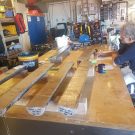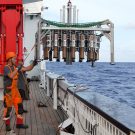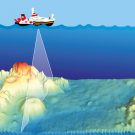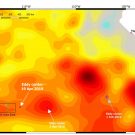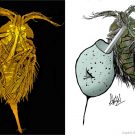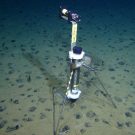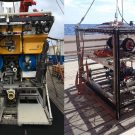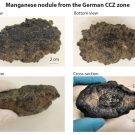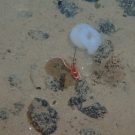by Henko de Stigter (Royal Netherlands Institute for Sea Research, NIOZ) Until somebody came up with the idea of mining polymetallic nodules from the abyssal depths of the Pacific Ocean, this place was one of the remotest and quietest on our planet. Far away from the brute natural forces of storms, floods, landslides, tsunamis and […]
A small world between grains / Eine kleine Welt zwischen den Sandkörnern
by Dr. Sven Rossel, Katja Uhlenkott und Ann-Kathrin Weßel (deutsch s.u.) “Ah, you’re playing with mud again.” That is something biologists and geologists hear quite often on board. And yes, we are one of the parties “playing with mud”. But actually we, the biologists from Senckenberg, German Centre for Marine Biodiversity Research, are not interested […]
Mapping the seafloor/Die Kartierung des Meeresbodens
(Deutsche Version unten) How do you plan research that is to be conducted at the seafloor in 4000 meter water depth? How do you choose the locations for your studies in a large area that you may not know much about yet? How do you pick the best spot to deploy sensors? – Which path […]
Wer ist eigentlich Eddy?/Who actually is Eddy?
(English version below) Das war eine häufige Frage an Bord zu Beginn unserer Forschungsfahrt. Denn das „Eddy“ Teil unserer wissenschaftlichen Untersuchungen wird, ergab sich relativ kurzfristig. Eddies sind temporäre Wasserwirbel mit einem Durchmesser von mehreren hundert Kilometern, die lange Strecken durch den offenen Ozean zurücklegen können, bevor sie sich irgendwann auflösen. Sie können von der […]
Phantastische Tierwesen und wo sie zu finden sind/Fantastic Beasts and Where to find them
(English version below) Tief, fremd und unbekannt: So wird die Tiefsee häufig beschrieben. Die meisten der Tiere in der dunklen Tiefseeebene 4000 Meter unter unserem Schiff sind bisher unentdeckt und nur wenige wurden wissenschaftlich beschrieben. Hier möchten wir einige der Arten vorstellen, die wir während der Fahrt SO268 bereits entdeckt haben oder von denen wir […]
BOBO and the 7 (+7) dwarfs: How to sense the deep sea
by Sabine Haalboom (NIOZ) The first half of the cruise has passed and we’ve finished the baseline studies in the Belgian license area. Doing my PhD research in marine geology at the Royal Netherlands Institute for Sea Research (NIOZ), my main interest is the particle dynamics in the bottom boundary layer (i.e. the layer close […]
Glimpsing through the eyes of deep-sea cameras/Ein Blick durch die Linse von Tiefsee-Kameras
– The Ocean Floor Observation System (OFOS) and Remotely Operated Vehicle (ROV) – (deutscher Text siehe unten) Many samples that marine biologists gather during research cruises are taken “physically”, such as deep-sea mud that is heaved up from the seafloor onto the deck via different coring gears, and gets further processed in the labs. With […]
Schätze der Tiefsee / Treasures of the Deep
(English below) Manganknollen – Entstehung und wirtschaftliche Relevanz von Jessica Volz, Sophie Paul und Julia M. Otte Während der ersten globalen Forschungsexpedition der HMS Challenger in den 1870er Jahren wurde das große Ressourcenpotential der Tiefsee deutlich. An Bord der HMS Challenger wurden zahlreiche unbekannte marine Organismen sowie mineralische Konkretionen vom pazifischen und atlantischen Meeresboden, die […]
SO268: What’s up on the seabed?
At the bottom of the Ocean, in ~4000m water depth they can be found in high abundances: Manganese nodules. Industry and states are interested in these potato-sized objects as a new metal resource. But before commercial mining will start, the potential ecological impacts need to be investigated. Therefore, the project MiningImpact (funded through JPI Oceans) […]
This is the end …
Not quite yet but the end of the expedition (EoX in IODP language) is in sight. We are now in our eighth week of the expedition and thus all of us are looking forward to get back on land and even more to get back home to our families and friends (not that we wouldn’t […]
